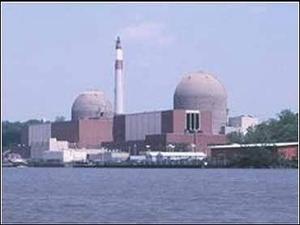Nuclear mattersDebate over extending operation of aging NY reactor
The Indian Point Energy Center is located on the banks of the Hudson River just twenty-four miles north of Manhattan; its reactors are aging: the first reactor at the center began operating in 1962 and shut down in 1974; two new reactors were built in 1974 and 1976; the plant operator seeks permission from the U.S. government to extend operations at the plant; many locals oppose the extension, citing what they say are inadequate emergency evacuation plans in the event of a disaster, and the damage the plant cooling system inflicts on aquatic life

Indian Point facility on the bank of New York's Hudson RIver // Source: cbslocal.com
The Indian Point Energy Center is a 3-unit nuclear power plant in Buchanan, New York. Located on the banks of the Hudson River it is just twenty-four miles north of Manhattan and provides up to 30 percent of the electricity used by New York City and Westchester County. The first reactor at the center began operating in 1962 and shut down in 1974. Two new reactors were built in 1974 and 1976.
On 3 December 2010 the Nuclear Regulatory Commission (NRC) issued a report stating there are no environmental reasons for denying a 20-year license renewal to the Indian Point nuclear power plant in Buchanan, New York. This, however, has not ended the debate about the plant’s continued operation as the New York State Department of Environmental Conservation determined in April the plant’s cooling system violates state standards. Each day the plant draws an estimated two and a half billion gallons of water from the Hudson River which is then circulated through the plant to cool the reactor core before it is recycled into the river (“New York denies water permit for Indian Point nuclear plant,” 5 April 2010 HSNW). It must be noted that this circulated water never comes into contact with radioactive material.
Environmentalists and the DEC still consider this a problem and claim that over one billion aquatic organisms are killed each year either by being sucked into the system or being caught in the heated water discharges. The solution proposed by The DEC is to construct large cooling towers that would allow for a closed system and prevent 90 percent of the aquatic damage. Entergy, the company that owns and operates the reactor, has stated, however, that the construction of these towers would do more environmental harm and would force the company to violate EPA standards for air quality due to the explosions needed to excavate the foundations for the towers as well as the salt and silica particles that would be released into the atmosphere by the cooling towers. Additionally Entergy has stated it makes more economic sense to close the facility that provides 2,000 megawatts to Westchester county and NYC than to build the towers estimated to cost more than $1 billion. Instead the company has proposed placing grates in front of the intake pipes to prevent fish and other aquatic organisms from being sucked in.
In addition to the impact of the plant on fish populations, some residents of the areas surrounding the Indian Point reactor say there are no plans in place to deal with an emergency at the facility and that in any event nuclear reactors should not be placed near population centers. This sentiment comes on the heels of a transformer explosion at the reactor on 7 November, in which automatic safety protocols were activated and the reactor was shut down without the release of any radiation and investigation revealed that no one was hurt (“Two nuclear reactors shut down Sunday because of problems,” 9 November 2010 HSNW).
The Westchester county government says it does have emergency plans, including evacuation procedures that meet NRC standards. The county distributes booklets detailing these evacuation procedures as well as other plans to residents of the federally mandated Emergency Planning Zone which can be found here. The Westchester county government says it also has a supplemental emergency notification system that allows residents of the area to be contacted by e-mail or cell phone if an emergency occurs.
